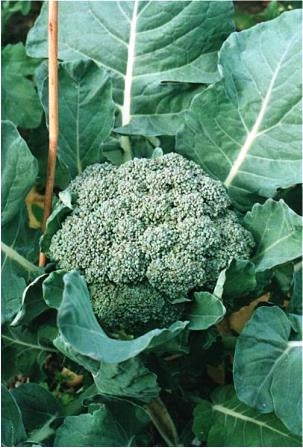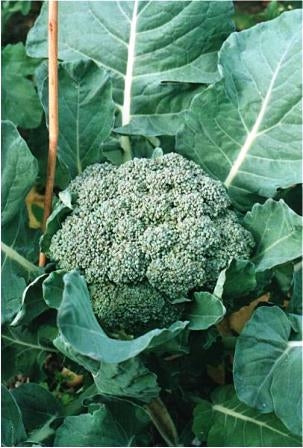NATALINO CALABRESE BROCCOLI - ko22
Have a question?

NATALINO CALABRESE BROCCOLI - ko22
Dettagli
Scientific name: Brassica oleracea L. conv. botrytis (L.)
Family: Cruciferae – Brassicaceae
Brief history and botanical notes on the plant
Broccoli (Brassica oleracea L. conv. botrytis (L.) Alef. var. cymosa Duch.) differs little from cauliflower: it belongs to the Cruciferae family – Brassicaceae, tribe: Brassiceae –. Species: Brassica oleracea L. var. botrytis L.. The head (the set of florets) is commonly called a cima, hence the name “cymosa”.
Broccoli, although a member of the cauliflower family, is distinguished by its sprouts or secondary inflorescences. This peculiarity likely gave it the name "broccolo" (brocco is the obsolete term for sprout). It is one of the oldest cultivated vegetables.
Known since ancient times, it was considered sacred by the Greeks; the Romans used it to treat a variety of ailments and ate it raw before banquets to help the body absorb alcohol better. In Italy, it first became popular in Tuscany and southern Italy. Its most widespread cultivation is in India, China, France, Italy, and the United States.
Cauliflower is a biennial herbaceous plant with a shallow taproot. Its erect stem (15 to 50 cm long) bears several dozen ribbed leaves, the outer ones being larger, varying in color from deep green to gray, and covered in waxy bloom, while the inner leaves are yellowish or light green and often completely cover the edible part.
The edible part, the corymb, an inflorescence derived from a hypertrophied apical bud, is the result of repeated branching of the terminal portion of the plant's main axis. The corymb can take on many different shapes. The convex upper surface of the corymb is formed by a very large number of apical meristems.
The actual inflorescence is a raceme and arises from the elongation of the fleshy peduncles of the corymb. As these peduncles elongate, they branch several times. The flowers of the first branches abort, and only those from the fourth to eighth order onward are fertile. The flowers are yellow and typical of cruciferous plants. Heterosexual fertilization is the predominant form. The fruits are siliques of varying shapes and lengths; they can contain up to 25 seeds, round, ranging in diameter from 1 to 2.5 mm, and reddish-brown or bluish, almost shiny.

Needs
It prefers cool, humid climates, but the numerous existing varieties allow it to be grown throughout Italy. Temperature is of particular importance in the north, as it is the most important climatic factor, both during the transition from vegetative to reproductive stage and before and after. For early cultivars, the optimal temperature for corymb formation is around 17°C. Temperatures above 20°C delay the transition to the reproductive stage, and the quality of the corymbs declines. Low temperatures can also damage the plant at various stages. If the plant has formed 6-8 leaflets and is subjected to low temperatures, "blind" plants, meaning without inflorescences, may develop. Frost causes the clumps that form the edible part to boil.
It requires medium-textured, deep, fresh, organically rich, and well-drained soil. It tolerates acidic soils and boron deficiencies.
It benefits from companion planting with many plants, such as lettuce and spinach, tomatoes, celery, and aromatic and medicinal herbs in general. Avoid combining it with garlic and onion.
Sowing and transplanting times
Cultivation is carried out at different times of the year, depending on the location and the cultivars used. Monocropping is absolutely avoided, especially if plant debris, particularly if diseased, is not eliminated. Although direct sowing provides excellent results, today, especially with hybrids, seedlings grown in nurseries in trays are used, subsequently transplanted from July to September. Crop rotation with legumes is excellent.
Depending on the size of the plants, planting density varies. Late varieties are larger than early varieties, so planting distances vary from 60 to 100 cm between rows and 40 to 70 cm along the rows, with a planting density ranging from 15,000 to 30,000 per hectare.
Processing
They require deep tillage to facilitate the development of the root system.
Fertilization
For the production of 10 tons of corymbs the plants remove approximately 130 kg of
nitrogen, 40 of phosphorus, 140 of potassium and 50 of CaO and 7 of Mg. It is hungry for nitrogen and well-matured organic matter, represented by vegetable compost or well-matured manure.
Products
For marketing, broccoli is prepared leafless (only the outermost large leaves are removed, while the others are left to protect the head and just sprouted at the end), crowned (only the outermost large leaves are removed, while the others are cut to a maximum of about 3 cm above the head), defoliated (all leaves are removed except the innermost, young, tender ones), naked (all leaves are removed).
Broccoli can be eaten raw, seasoned with oil, salt, and lemon; or cooked in various ways: boiled and sautéed, battered and fried, or used in soups and broths.
Cultural care
Weed control can be carried out in the early stages of the cycle using mechanical means.
It is important to eliminate crop residues at the end of the cycle.
Irrigation
It requires a constant supply of water; therefore, in summer-autumn crops, it requires irrigation.
Adversity
We recall Alternaria (Alternaria brassicae), Hernia of crucifers (Plasmodiophora brassicae), basal rots (Sclerotinia spp., Rhizoctonia solani, Phoma lingam), and downy mildew (Peronospora brassicae, Peronospora parasitica). It is also susceptible to some bacterial diseases (Xanthomonas campestris, Erwinia carotovora).
The most important animal parasites are aphids (Myzus persicae, Brevicoryne brassicae), noctuaries, cabbage flies (Mamestra brassicae, Mamestra oleracea, Pieris brassicae), wire squirrels (Agriotes spp.), stingrays (Phyllotreta spp.), weevils (Baris spp., Ceuthorrhyncus spp.) and the cabbage fly (Delia radicum).
Defense Products
Downy mildew can be prevented by spraying with horsetail decoction.
Cruciferous hernia and numerous basal and bacterial rots are severely limited by proper crop rotation (avoid growing any cruciferous vegetable for 3-4 years on the same plot), by spreading lithothamnium on the soil before transplanting, and by spraying with horsetail decoction.
Bacillus thuringiensis and neem oil can be used to control cutworms and cabbage whites.
Flea beetles can be a serious problem, especially in compact, dry soils. They can be contained in small vegetable gardens by using broom branches and dusting vegetation with lithothamnium and bentonite. In severe cases, use pyrethrum.
Cabbage fly control is primarily preventative and essentially involves destroying vegetation debris, possibly also removing the surrounding root ball. Interplanting, for example, with clover, hinders egg-laying.
Production and collection
Approximately 4 kg of broccoli are produced per square meter. The size and weight of the corymbs, however, vary considerably depending on the cultivar: in some older cultivars, they exceed 30 cm in diameter and weigh 3-5 kg; in those commonly used today, the defoliated corymbs generally do not exceed 1.5 kg.
The harvest is staggered for all classic Italian cultivars and runs from October to May.
The corymbs are harvested when they are compact, and in any case before the individual florets or florets that make up the corymb begin to separate. Since ripening does not occur simultaneously, 3-6 harvests are necessary. The corymbs can be cut with or without leaves.
Nutritional values
Cauliflower is very rich in water (more than 90%), but with a non-negligible energy value
(25-30 calories per 100g of edible portion; 2% protein). It's high in vitamin C, potassium, phosphorus, and calcium. It also contains several sulfur compounds that produce its characteristic odor when cooked and cause some digestive difficulties. However, like other cruciferous vegetables (especially broccoli), it contains compounds that appear to have anti-tumor properties. It's high in fiber, which aids intestinal function and prevents digestive cancers. Being very filling, it's a useful addition to a low-calorie diet.
There are numerous therapeutic uses as an anti-anemic, emollient, diuretic, healing, purifying, vermifuge.
Family and variety
Cultivars are distinguished by whether or not cold temperatures are needed to form the corymb. Some cultivars don't require cold temperatures to form the edible part, but they do require cold temperatures to form the actual inflorescence, while others (late cultivars, which are typically biennial) require cold temperatures for both the edible part and the inflorescence.
Varieties derived from old local populations and F1 hybrids are available commercially. In addition to Romanesco, we also find the "Ramoso Calabrese," "Verde Calabrese," and "Riccio di Sarno," as well as the "Broccolo di Albano," "Gigante di Como," "Broccolo di Verona," and the "Covert F1" hybrid.
Biodynamics
In addition to spraying the plants and during production, the addition of well-composted organic matter via biodynamic heaps helps limit growth imbalances and consequent parasite attacks, and allows the corymbs to develop well.
It is advisable to pot-mold the propagation material with soil mixed with horn manure 500 or with diluted biodynamic trunk paste.
Using the biodynamic calendar:
To preserve quality and shelf life, harvest on leaf days.


